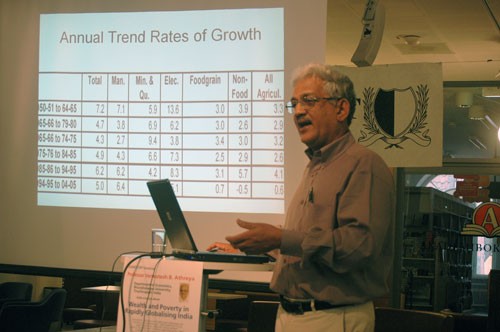SWEDISH SOUTH ASIAN STUDIES NETWORK
SASNET/UPF lecture by Prof. Venkatesh Athreya, Monday 12 May 2008
 • Professor Venkatesh B. Athreya from the MS Swaminathan Foundation in Chennai, India, held a well-attended SASNET/UPF lecture at Lund University on Monday 12 May 2008. The lecture was held in the evening at Athen, AF-Borgen at Sandgatan 2 in Lund. It was jointly organised by SASNET and the Association of Foreign Affairs at Lund University (UPF). More information (as a pdf-file)
• Professor Venkatesh B. Athreya from the MS Swaminathan Foundation in Chennai, India, held a well-attended SASNET/UPF lecture at Lund University on Monday 12 May 2008. The lecture was held in the evening at Athen, AF-Borgen at Sandgatan 2 in Lund. It was jointly organised by SASNET and the Association of Foreign Affairs at Lund University (UPF). More information (as a pdf-file)
Prof. Athreya talked about ”Wealth and Poverty in
Rapidly Globalising India”. Among Prof. Athreya’s most well-known publications are ”Literacy and Empowerment” (1996) and ”Barriers Broken” (with Djurfeldt and Lindberg, 1990).
Currently he is co-operating with the Swedish sociologists Göran Djurfeldt and Staffan Lindberg, Dept. of Sociology, Lund University; and the two Indian researchers Dr. R. Vidyasagar from the Madras Institute of Development Studies in Chennai, India, and Dr. A. Rajagopal from SaciWATERs in Hyderabad, in a restudy of 300 agricultural households in Tiruchirapalli District, Tamil Nadu, people who were originally interviewed in 1979/80. The reason for coming to Lund was actually to participate in a concluding workshop regarding this project. More information about the research project.
Fact sheet presented at the lecture:
 The 55th round of the NSS, which used a different methodology from all previous NSS rounds and arrived at lower poverty estimates, has confused about what happened to poverty and inequality in India during the 1990s. A consensus from earlier NSS rounds that poverty reduction had been setback during the 1990s was challenged. This was bolstered apparently by some ‘adjustments’, which although agreeing that the 55th round had overestimated poverty reduction, claimed that the number of poor had nonetheless fallen by 30-45 million. However, a detailed re-examination shows that these‘adjustments’ got it wrong, and that the earlier consensus was correct after all. It is now certain that economic inequality increased sharply during the 1990s in all its aspects and, as a result, poverty reduction deteriorated markedly despite higher growth. It is most likely that the number of poor increased during the decade. This has implications for policy, and lessons for future survey design. (Himangshu and Sen, EPW 2004)
The 55th round of the NSS, which used a different methodology from all previous NSS rounds and arrived at lower poverty estimates, has confused about what happened to poverty and inequality in India during the 1990s. A consensus from earlier NSS rounds that poverty reduction had been setback during the 1990s was challenged. This was bolstered apparently by some ‘adjustments’, which although agreeing that the 55th round had overestimated poverty reduction, claimed that the number of poor had nonetheless fallen by 30-45 million. However, a detailed re-examination shows that these‘adjustments’ got it wrong, and that the earlier consensus was correct after all. It is now certain that economic inequality increased sharply during the 1990s in all its aspects and, as a result, poverty reduction deteriorated markedly despite higher growth. It is most likely that the number of poor increased during the decade. This has implications for policy, and lessons for future survey design. (Himangshu and Sen, EPW 2004)
Many economic and social indicators suggest that not only is the level of absolute poverty in India high, there has also been an adverse impact of neoliberal policies on poverty. And yet, the poverty estimates by the Planning Commission and many
individual academics, both using a method that renders irrelevant the question of a nutrition norm, show low levels as well as decline in poverty over the 1990s and beyond. This article proves that both comparisons over time of the all-India and state-level estimates of poverty as well as any comparison at a point in time of poverty levels across states, obtained by this method, are invalid. Using a direct poverty estimation route of inspecting and calculating from current National Sample Survey data the percentage of persons not able to satisfy the nutrition norm in calories, the author finds that in 1999-2000 nearly half of the rural population who are actually poor have been excluded from the set of the officially poor. For 2004-05, while the official estimate of rural poverty is 28.3 per cent, the author’s direct estimate of persons below the poverty line is 87 per cent. There is clear evidence of a large and growing divergence over time between the author’s direct estimates of poverty and the official indirect estimates. (Utsa Patnaik, Neoliberalism and Poverty in India, EPW 2007)
Our estimate that a little more than three-fourths of the Indian people are poor and vulnerable in 2004-05, based on a value that is double the official poverty line, is consistent with other estimates. For example, the World Development Report 2006 of the World Bank reports 35 per cent of the Indian population as living below the extreme poverty line of one PPP $ per day. (Arjun Sengupta and Others, EPW 2008)
SASNET - Swedish South Asian Studies Network/Lund
University
Address: Scheelevägen 15 D, SE-223 70 Lund, Sweden
Phone: +46 46 222 73 40
Webmaster: Lars Eklund
Last updated
2008-05-15
